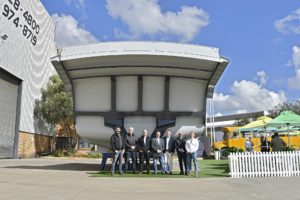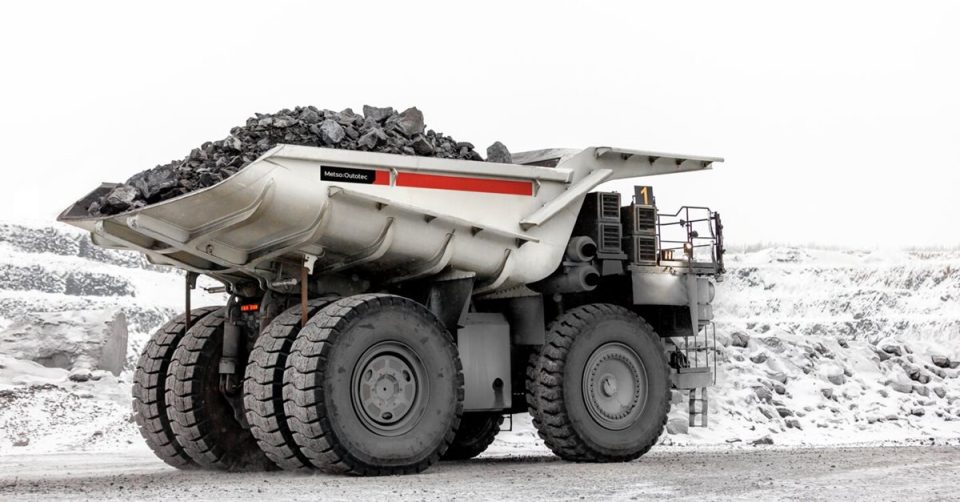Metso Outotec launched its innovative Mining Truck Body (MTB) back in 2019; and while since then it has been an interesting ride – dealing with pandemic supply chain interruptions and operating in a highly competitive space against advanced light steel and other rubber offerings – the solution is now quickly gaining traction in the mining market.
Notably, it has now been installed on all major mining truck classes from 40 ton to 400 ton (363 t); the latter running on the Liebherr T 284 at a major copper mine in the Americas. It has also been used across most major commodities – this includes in Australian coal on the Caterpillar 793, in addition to all the major hard rock metal mine types.
Other examples include installation on the 313 t Caterpillar 795F AC trolley trucks and 290 t Komatsu 930E trucks at Boliden’s Aitik copper mine and on Hitachi EH3500 trucks at Terrafame’s Sotkamo nickel mine in Finland. In smaller truck classes, applications have included working closely with truck supplier and distributor BIA for delivery of bodies for the Komatsu HD605-8 for quarrying customers.
The 2022 launch of the first Metso Outotec MTB in South Africa

Most recently, working closely with local fabricator, Efficient Engineering in Germiston, the MTB has entered the South African market, where the 150 t class of truck such as the Caterpillar 785, is widely used in hard rock mining including iron ore and manganese, and as such represent a sizeable potential market. The first South African body was designed for a 90 t Caterpillar 777 and featured a new ‘Zebra’ colour scheme to highlight the MTB structure where the MTB steel ribs are left dark with the main body in a very light grey.
The unique, one-piece, lightweight hybrid haul truck tray combines the best of high-strength steel and rubber. Specifically, it differs from a standard steel body by its lighter, but resistant, rounded shaped design in ultra high-strength steel combined with a Trellex™ rubber lining. This makes it possible to obtain a 20% to 30% lighter body without sacrificing rigidity. Lighter weight also means more sustainable, in keeping with Metso Outotec’s Planet Positive approach – why? Lighter body weight and increased payload equal lower fuel consumption per hauled tonne.
It is built in a modular way so that only the worn elements need to replacing. Plus it is safer – unlike with all steel body liner changes, welding or oxy-cutting is not required as it uses bolted fixing with pre-welded studs. Finally it is quieter and easier on operators – it offers about 97% less vibration on a steel body and reduces noise on loading by about 10-20 db, typically from 95 db down to 80 db but in fact equates to 50% in perceived noise. These safety and operator friendly aspects are increasingly important in today’s mining market.
However, the biggest boost is in maintenance, where the rubber lasts up to 300-500% longer than steel resulting in a significant operational cost saving. It also offers customisation, which it calls Flexible Lining – different rubber grades and compounds are used for different mined materials – for a sticky material like bauxite, a flexible and custom-designed rubber lining can prevent carry-back; for a highly abrasive iron ore, a different rubber grade can drastically cut wear effects.
IM spoke to Carl Samuelson, who has headed up development and market introduction of the MTB since launch as Metso Outotec Director Loading and Hauling Solutions
How would you summarise the evolution of the Metso Outotec Mining Truck Body since launch with regard to design and technology?
The evolution of the MTB continues, and the design never stands still – it is continuously updated with new features, structural design tweaks and new rubber grades with a focus on reducing even more weight plus further improvement in wear life and anti carryback characteristics.
Carl Samuelson, Metso Outotec Director Loading and Hauling Solutions

You have now supplied them for trucks right up to 400 ton class? What extra challenges come with bodies of this size?
Actually, it’s generally easier to build a big body than a small one, the real technical challenge is to build a really small body. There is much less room to play with and weight savings are harder to find. But we have succeeded very well in the design of smaller bodies and have managed to incorporate the design features in our larger bodies. In addition to the sizes, we have also worked with all of the major rigid truck OEMs, including Caterpillar, Komatsu, Liebherr and Hitachi.
Does your truck body offer advantages both for soft rock applications as well as abrasive hard rock?
Since we work with a modular design we adopt the rubber lining to suite the application, this means we can handle every type of rock material. So the lining is always tailored to the application. With high strength steel you can use different grades but with nowhere near the same range of characteristics, especially the ability to handle sticky and highly abrasive materials. We often find a solution together with our customer where we optimise payload and maintenance.
Can you share any data on typical maintenance savings for a large mining truck over time?
A typical mining truck go in for maintenance every 8-9 000 h and it’s a quite an extensive welding operation that will keep the truck body in the workshop for some weeks. After a second refurbishment an ordinary body is often in such a bad condition that it’s scrapped. With a MTB with rubber lining we typically change out 30% of the bottom lining (rubber) after 18-20,000 h. This takes two people 2-3 days and then the truck body is back in operation for another 12-20,000 h. There is no welding involved during this maintenance so the amount of risk work is greatly reduced.
Can you also share any direct customer feedback or comments on the bodies?
We have had very good customer responses. I would say after payload increase and fuel/tonne savings the increased wear life is very much appreciated. In many markets the reductions of noise and vibration have come up as the number one advantage as in both of these areas the MTB makes an enormous difference.
Many of the mines have not deployed the MTB across their whole fleet – can you explain why this is?
In fact, we have some sites that have fully converted their fleet and they have achieved great improvements. The main reason why we don’t have more full fleets I would say it’s because it take a bit of time to implement a full fleet. First the product must be proven and after that customers generally want to use their existing investment (truck bodies) as long as possible, so when an old body is phased out we supply a new one to replace it. In some cases, these customers have already been using our own Trellex™ rubber linings in their steel truck bodies, which also bring long lasting performance, but these are also being replaced with the MTB due to the overall range of benefits? Also I would honestly say that the COVID pandemic did have a quite a big effect as a a lot of projects were temporarily halted in early 2020.
Can you reveal more details about your recent launch in the South African market?
We just recently built our first truck body in South Africa for the African market, and we have some really good partners there that helped us realise the project. Today, we have built up capabilities to supply the MTB with 100% local content using our design – this gives us a lot of flexibility to work with fabrication partners as demand starts to ramp up. The African market is interesting for us due to its size and the fact that it’s very much hard rock dominated. There are very few alternatives that can handle payload management in hard rock like an MTB with the added maintenance, noise and vibration upside. We have had a very positive first response and I’m sure Africa will become one of our key markets. Also, we plan to grow from our existing supplier and partner base and as we see stable and rising volumes in particular mining markets we could quite easily set up local direct supply and we are investigating a couple of possible options for this today.



